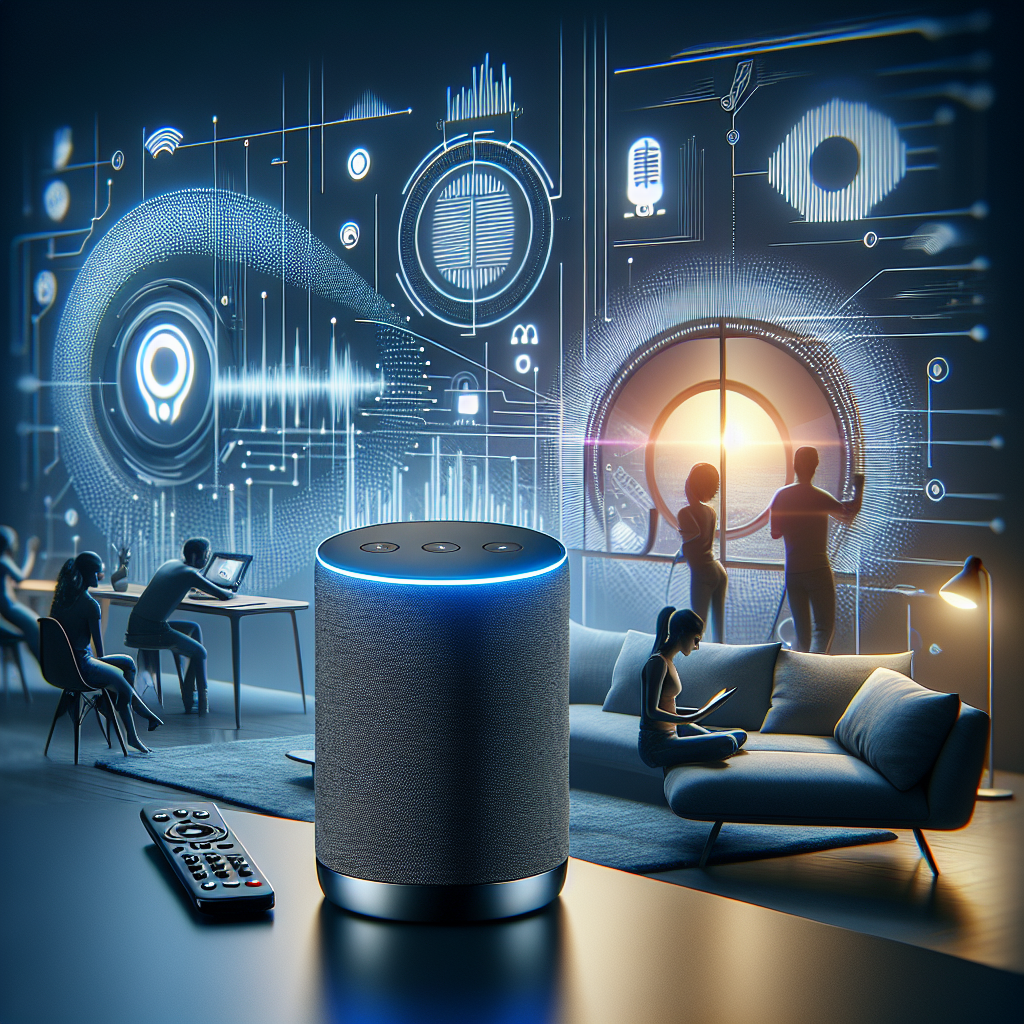Looking to amplify your music streaming and entertainment options? Look no further than smart speakers. With these technological gems, you can effortlessly enjoy your favorite tunes and indulge in a wide array of entertainment options. Whether you want to listen to a curated playlist or catch up on the latest podcasts, smart speakers offer a convenient and user-friendly way to enhance your audio experience. So, why not make the most of your smart speaker and unlock a world of limitless entertainment possibilities? Let’s delve into the ins and outs of using smart speakers for music streaming and entertainment.

Getting Started with Smart Speakers
Choosing the right smart speaker
When it comes to choosing the right smart speaker, there are a few factors to consider. First and foremost, think about the voice assistant that the speaker incorporates. Popular options include Amazon’s Alexa, Google Assistant, and Apple’s Siri. Each assistant has its own strengths and capabilities, so choose one that aligns with your preferences and needs.
Additionally, consider the speaker’s audio quality. If you’re an audiophile or enjoy listening to music with optimal clarity, look for speakers with high-quality audio components. Another factor to consider is the speaker’s compatibility with other smart devices you may already own, such as smart home devices or streaming services.
Setting up your smart speaker
The process of setting up your smart speaker typically involves a few simple steps. First, ensure that your speaker is powered on and connected to an electrical outlet. Next, download the corresponding app for your smart speaker on your mobile device. The app will guide you through the setup process, which usually involves connecting your speaker to your Wi-Fi network.
During setup, you may also need to link your speaker to your existing accounts, such as your streaming music services or smart home apps. This allows your smart speaker to seamlessly integrate with your existing setup and provide a personalized experience.
Connecting to your Wi-Fi network
For your smart speaker to function properly, it needs to be connected to your Wi-Fi network. Refer to your speaker’s user manual or the app’s instructions to find the appropriate settings. Typically, you’ll need to open the app and navigate to the Wi-Fi settings section. From there, select your home network from the list of available options and enter your Wi-Fi password if prompted. Once connected, your smart speaker will be able to access the internet and provide you with a range of features and functionalities.
Playing Music on Smart Speakers
Linking your streaming accounts
To fully enjoy music streaming on your smart speaker, it’s essential to link your streaming accounts. Most smart speakers support popular music streaming services such as Spotify, Apple Music, and Amazon Music. By linking your accounts, you’ll have direct access to your favorite playlists, albums, and personalized recommendations.
The process of linking streaming accounts varies depending on the voice assistant and speaker you own. Generally, you can link your accounts through the smart speaker’s app. Look for settings related to music preferences or streaming services and follow the prompts to log in to your accounts.
Using voice commands to play music
Once your streaming accounts are linked, you can start using voice commands to play music on your smart speaker. Simply wake up the voice assistant by saying the designated wake word (e.g., “Alexa” for Amazon Echo devices) followed by your command. For example, you could say, “Hey Google, play my Rock playlist on Spotify.”
Voice commands allow you to control various aspects of music playback, such as requesting a specific song, asking for recommendations based on your mood or genre preference, or skipping to the next track. Experiment with different commands and discover the ease and convenience of hands-free music control.
Creating playlists
If you want to create personalized playlists on your smart speaker, most voice assistants allow you to do so with voice commands. Simply instruct your smart speaker to create a new playlist and provide a name for it. Once the playlist is created, you can add songs to it using voice commands or through the app.
Creating playlists can be a fun and creative way to curate your favorite tracks, whether you’re hosting a party, working out, or simply enjoying a quiet evening at home.
Controlling playback
Controlling music playback on your smart speaker is as easy as using voice commands or tapping the controls on the app. You can pause, play, skip, and adjust the volume with simple voice instructions. If you’re hands-free or need to control playback from a distance, this feature can be particularly useful.
In addition to basic playback control, some smart speakers also offer advanced features like cross-platform syncing, allowing you to seamlessly transition playback from your smart speaker to your mobile device or another speaker in a different room. Explore the options available on your smart speaker and make the most of its playback control capabilities.

Discovering New Music
Exploring curated playlists
Smart speakers can help you discover new music by providing access to a wide range of curated playlists. These playlists are typically created by music experts or tailored based on popular genres, moods, or themes. You can often access curated playlists through your streaming music service by asking your smart speaker to play a specific genre or asking for recommendations.
Take some time to explore the curated playlists available on your smart speaker. It’s a great opportunity to discover new artists, genres, or songs that you may not have come across otherwise.
Following artist recommendations
Another way to discover new music is through artist recommendations. voice assistants on smart speakers often provide personalized suggestions based on your listening habits and favorite artists. Asking your smart speaker for recommendations based on a particular artist or genre can lead you to exciting new music you might not have otherwise discovered.
By following artist recommendations, you can expand your musical horizons and explore different genres, styles, and even international music.
Discovering new music through smart speaker apps
In addition to streaming music services, many smart speakers have their own dedicated apps that provide access to additional features and content. These apps often offer exclusive music and playlists, giving you even more options to discover new music.
Explore the app associated with your smart speaker and see what additional music discovery features are available. You may find hidden gems, artist interviews, or even live performances that can enhance your music streaming experience.
Streaming Podcasts and Audiobooks
Subscribing to podcasts and audiobook services
If you’re a fan of podcasts or audiobooks, your smart speaker can open up a world of entertainment options. To get started, you’ll need to subscribe to podcast and/or audiobook services. Popular podcast platforms include Spotify, Apple Podcasts, and Google Podcasts, while popular audiobook services include Audible and Google Play Audiobooks.
Once you’ve subscribed to these services, you can link them to your smart speaker’s app to gain access to your favorite podcasts and audiobooks.
Playing podcasts and audiobooks using smart speakers
Playing podcasts and audiobooks on your smart speaker is as easy as using voice commands. Simply ask your smart speaker to play a specific podcast or audiobook by title, author, or genre. Your voice assistant will locate and start playing the content for you.
For longer-form content like audiobooks, your smart speaker can even remember your progress, allowing you to pick up where you left off and resume listening seamlessly.
Controlling playback and setting bookmarks
Similar to music playback, you can control the playback of podcasts and audiobooks using voice commands or through the app. You can pause, skip, or adjust the volume of your content effortlessly with voice instructions.
If you’re listening to an audiobook and need to bookmark a specific section, your smart speaker can assist. Simply ask your voice assistant to set a bookmark, and it will remember the exact spot for future reference.

Controlling Smart Home Devices
Connecting smart home devices to your smart speaker
Smart speakers can serve as the central control hub for your smart home devices, allowing you to conveniently manage and operate various devices with voice commands. To connect your smart home devices to your smart speaker, you’ll need to ensure that they are compatible with the speaker’s voice assistant.
Typically, you can connect smart home devices through the smart speaker’s app. Look for settings related to smart home connectivity or device management, and follow the instructions to connect your devices. Once connected, you’ll be able to control lights, thermostats, security systems, and more with simple voice instructions.
Controlling lights, thermostats, and other devices with voice commands
One of the most convenient features of smart speakers is their ability to control smart home devices with voice commands. For example, you can say, “Hey Siri, turn off the living room lights” or “Alexa, set the thermostat to 72 degrees.”
By integrating your smart home devices with your smart speaker, you can create a seamless and hands-free experience in your home. Whether you want to set the mood with dimmed lights or adjust the temperature without leaving your seat, voice commands make it easy and convenient.
Playing Games and Entertainment
Playing interactive voice-controlled games
Smart speakers offer a range of interactive voice-controlled games that can keep you entertained for hours. From trivia games to choose-your-own-adventure stories, there’s something for everyone.
To explore the games available on your smart speaker, simply ask your voice assistant to suggest a game or browse through the available options in the app. With voice commands, you can participate in the gameplay and immerse yourself in a whole new interactive experience.
Listening to radio stations and live broadcasts
If you enjoy listening to radio stations or live broadcasts, your smart speaker can provide quick and easy access. Most smart speakers allow you to tune in to your favorite radio stations or even search for specific genres or stations from around the world.
To listen to radio or live broadcasts, simply ask your smart speaker to play a specific station or genre. With a vast selection of radio stations available, you can discover new music, catch up on news and sports, or enjoy live events happening anywhere in the world.
Streaming online content and videos
In addition to music and games, smart speakers also support streaming online content and videos. Depending on the capabilities of your speaker and voice assistant, you may be able to stream content from popular platforms like YouTube, Netflix, or Hulu.
To stream online content, link your video streaming accounts to your smart speaker’s app and use voice commands to request specific videos or shows. Whether you want to watch cooking tutorials or enjoy a movie night from the comfort of your couch, your smart speaker can make it happen.

Multi-room Audio and Grouping
Setting up multi-room audio
If you have multiple smart speakers in different rooms, you can create a multi-room audio setup for synchronized playback throughout your home. Setting up multi-room audio typically involves connecting your speakers to the same Wi-Fi network and configuring the settings through the smart speaker’s app.
Follow the instructions provided by your smart speaker’s app to create multi-room audio groups. Once set up, you can enjoy synchronized music playback in different areas of your home, creating a cohesive and immersive listening experience.
Grouping speakers for synchronized playback
Even if you don’t have multiple speakers, you can still enjoy synchronized playback by grouping your smart speaker with other compatible speakers. This allows you to expand the audio coverage in a specific room or create a surround sound effect.
To group speakers, refer to your smart speaker’s app and select the speakers you want to group. Follow the instructions to create the group, and you’ll be able to control playback and volume across all the speakers within that group.
Smart Speaker Voice Assistants
Understanding voice assistant capabilities
Voice assistants are at the heart of smart speakers, and understanding their capabilities is key to maximizing your smart speaker experience. Each voice assistant has its own unique set of skills and features, ranging from general knowledge questions to device control and integration with third-party services.
To explore the capabilities of your voice assistant, consider browsing through the available skills or actions in the app associated with your smart speaker. These skills or actions expand the functionality of your voice assistant, allowing you to perform tasks like ordering food, checking the weather, or getting news updates.
Customizing voice assistant settings
To personalize your smart speaker experience, you can customize various settings related to your voice assistant. For example, you can change the wake word that activates your voice assistant, adjust the volume or voice responsiveness, or enable additional features like voice recognition.
Dig into the settings section of your smart speaker’s app to explore the customization options available. By tailoring your voice assistant settings to your preferences, you can ensure a seamless and enjoyable interaction with your smart speaker.
Expanding functionality with third-party skills or actions
To extend the capabilities of your smart speaker, consider exploring third-party skills or actions developed by independent developers and companies. These skills or actions integrate with your voice assistant and add new functionalities.
You can find a wide range of skills or actions in the app associated with your smart speaker. Some popular examples include ordering pizza, playing trivia games, or controlling smart home devices that may not be directly supported by your voice assistant.

Troubleshooting and Tips
Common issues and solutions
While smart speakers are designed to be user-friendly, occasional issues may arise. Some common issues include connectivity problems, unresponsive voice assistants, or difficulty linking accounts. Fortunately, most issues can be resolved with simple troubleshooting steps.
Consult the user manual or the support resources provided by your smart speaker’s manufacturer for specific troubleshooting steps. If you’re unable to resolve the issue on your own, reaching out to customer support can often provide further assistance.
Optimizing audio quality
To ensure the best audio quality from your smart speaker, there are a few tips you can follow. First, consider the placement of your speaker. Placing it on a stable surface away from walls or other objects can help prevent sound distortion.
Additionally, adjusting the equalizer settings in your smart speaker’s app can fine-tune the audio output to your liking. Experiment with different equalizer presets or customize the settings manually to achieve the desired audio quality.
Managing privacy settings
Smart speakers raise concerns about privacy and data security. To address these concerns, most smart speakers offer privacy settings that allow you to control data collection and voice recordings. These settings may include options to disable voice recognition, delete voice recordings, or limit data sharing with third parties.
Review the privacy settings available in your smart speaker’s app and adjust them according to your preferences. It’s important to strike a balance between enjoying the convenience of a smart speaker and protecting your privacy.
Smart Speakers and Privacy
Understanding privacy concerns
As with any Internet-connected device, privacy concerns surround the use of smart speakers. People worry about voice recordings, data collection, and potential misuse of personal information. Understanding these concerns can help you make informed decisions regarding your smart speaker usage.
Voice recordings captured by smart speakers are typically stored securely and can be deleted by the user. However, it’s essential to review the privacy policies of your smart speaker’s manufacturer to understand how your data is handled and protected.
Protecting your privacy
To protect your privacy while using a smart speaker, start by enabling any available privacy features or functions. This may include options to mute or disable the microphones when not in use, reviewing and deleting your voice recordings regularly, or setting up voice recognition for enhanced security.
Furthermore, keep your smart speaker’s software up to date to ensure you have the latest security patches. By taking the necessary precautions, you can enjoy the benefits of a smart speaker while maintaining your privacy.
Limiting data collection and voice recordings
If you’re concerned about data collection and voice recordings, you have control over how much information you share with your smart speaker. Review the privacy settings in the associated app to customize the data collection preferences.
Some smart speakers allow you to limit voice recordings or even disable voice recognition entirely. By adjusting these settings according to your comfort level, you can strike a balance between enjoying the convenience of a smart speaker and safeguarding your privacy.
In conclusion, smart speakers offer a plethora of features and functionalities that can enhance your music streaming, entertainment, and home automation experience. By choosing the right smart speaker, setting it up correctly, and exploring the various capabilities, you can make the most of this innovative technology. Remember to prioritize your privacy and optimize your settings to ensure a secure and personalized smart speaker experience. So, get started with your smart speaker, immerse yourself in music, discover new entertainment options, control your smart home devices, and enjoy the convenience and entertainment it brings into your life!










